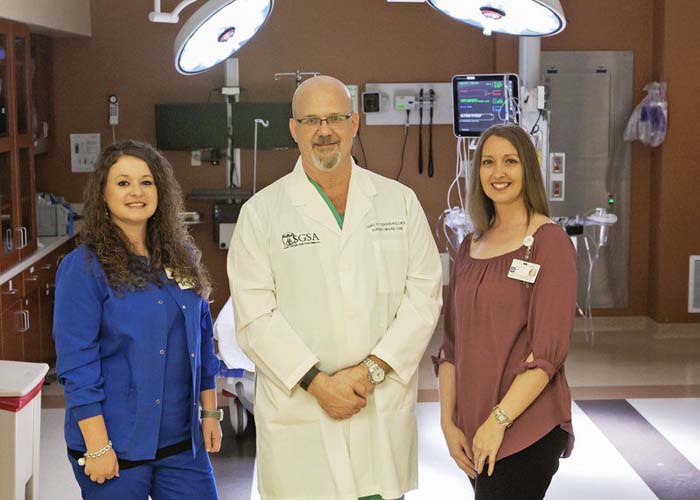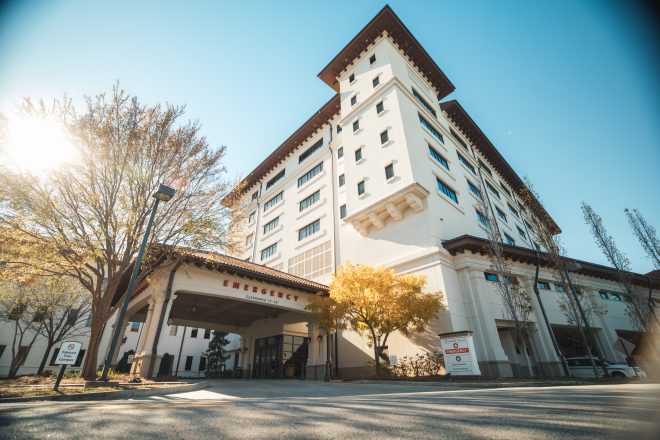Archbold saves lives with high-level trauma care
Published 10:14 am Wednesday, May 24, 2017

- Submitted photoArchbold is home to the only Level II Trauma Center in Georgia south of Macon. The designation as a Level II center reflects the ability to treat all injured patients with 24-hour immediate coverage by general surgeons, as well as coverage by orthopedic surgery, neurosurgery, anesthesiology, emergency medicine, radiology and critical care. Members of Archbold’s trauma team pictured from left to right: Daphne Stitely, Archbold trauma coordinator; general surgeon Greg Patterson, MD, Archbold trauma medical director; Shawna Baggett, trauma registrar.
In emergency medicine, the “Golden Hour” is the time period immediately following a traumatic injury. It’s the period when there’s the highest likelihood that prompt medical treatment will prevent a death.
Archbold Memorial Hospital general surgeon Greg Patterson, MD, the hospital’s trauma medical director, still remembers a young man at a hospital where he worked years ago in Augusta who Patterson says would still be alive if he had that prompt access to quality treatment.
Trending
The patient wasn’t properly diagnosed, and was driven several hours to another facility, with a scalp bleed. The man died from blood loss.
“In trauma situations, we have to get the patient to the right hospital in the right amount of time to save their life,” Dr. Patterson said. “That particular experience was a preventable death, and a perfect example of why having local access to trauma care and trained trauma professionals is so important.”
Patterson and the rest of the trauma team at Archbold train throughout the year to ensure those types of preventable deaths don’t happen on their watch while serving a large part of Southwest Georgia.
Archbold is home to the only Level II Trauma Center in Georgia south of Macon. The designation as a Level II center means that they’re able to treat all injured patients with 24-hour immediate coverage by general surgeons, as well as coverage by orthopedic surgery, neurosurgery, anesthesiology, emergency medicine, radiology and critical care.
“What sets us apart from emergency departments throughout the region is we have skilled people that are specially trained to handle trauma cases,” Dr. Patterson said. “We have to be ready at any time to handle any trauma case that comes our way. And it’s a large financial investment to maintain readiness like we do.”
A portion of the funding for the trauma centers around the state of Georgia comes from the “super speeder” law, which added $200 to fines for drivers traveling faster than 85 miles an hour on interstates or 75 mph on two-lane roads and also included increased fines for reactivation of suspended licenses.
Trending
“But that money doesn’t keep us open,” Dr. Patterson said referring to the ticket revenue. “It’s the dedication of the administrators and the board members of the hospital who value the ability to provide our region with access to critical, high quality trauma care.”
Prepare for the Worst, Aim for the Best
According to the Centers for Disease Control and Prevention, traumatic injury is the leading cause of death for children and adults ages 1 to 45. These are injuries often sustained in accidents like car crashes (blunt trauma) or from gunshot wounds or stabbings (penetrating trauma).
The motto of Archbold’s trauma center could easily be, “Prepare for the worst situation, but aim for the best outcome.”
The doctors and nurses at Archbold receive training and continuing education over and above that required by the medical board to obtain their designation as a trauma center by the American College of Surgeons.
“Our community can be very proud of the emergency and trauma care we have access to in our region. The quality of the surgeons we have is incredible. They are up-to-date on current cutting-edge practices, and their skill level is amazing,” said Kelli Vaughn, director of the emergency department and trauma services at Archbold.
Trauma Prevention
In addition to treating trauma, the team at Archbold, including Vaughn and trauma program manager Daphne Stitely, also participate in community outreach to help prevent trauma from happening in the first place.
“That is one thing about trauma,” Vaughn said. “Ultimately you’d love to work yourself out of a job.”
Some outreach efforts include programs to help decrease the instance of distracted driving, as well as promotion of home and fire safety and fall injury prevention in people over the age of 55.
The role of Archbold’s trauma center doesn’t end there, though. All patients are also entered into a national registry database to track the types of injuries being treated, and to evaluate the effectiveness of the care patients receive. That data is then used to make improvements to protocol and treatment plans at the hospital, as well as at other trauma centers around the country.
“Trauma care isn’t really always like the excitement you see on TV,” said Dr. Patterson. “But, a lot of what makes it worth it is that you can see someone who is badly injured and help them get back to work, and back to their daily lives.”
(info box)
Thomasville Treats Trauma
• The Archbold Trauma Center originally opened in 1988
• Following September 11 and a resurgence in interest trauma care, the Trauma Center was recertified in 2002 as a Level III Center
• After reapplying in 2003, the center was designated as a Level II center
• Surgeons must live within 10 minutes of the hospital to ensure quick response to emergency calls
• Cases have been flown in from all over South Georgia, even from east of Valdosta
• The Trauma Center maintains relationships with other medical centers like the Augusta Burn Center and The Shepherd Center for spinal cord and brain injury rehabilitation for quick referrals of specialized cases





